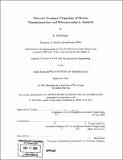Material invariant properties of shales : nanoindentation and microporoelastic analysis
Author(s)
Delafargue, A. (Antoine), 1981-
DownloadFull printable version (16.49Mb)
Other Contributors
Massachusetts Institute of Technology. Dept. of Civil and Environmental Engineering.
Advisor
Franz-Josef Ulm.
Terms of use
Metadata
Show full item recordAbstract
Shales compose the major part of sedimentary rocks and cover most of hydrocarbon bearing reservoirs. Shale materials are probably one of the most complex natural composites, and their mechanical properties are still an enigma that has deceived many decoding attempts from experimental and theoretical sides. Advanced experimental techniques, such as nanoindentation, and theoretical microporomechanics make it possible today to break such a heterogeneous material down to a scale where physical chemistry meets mechanics, to extract intrinsic material properties that do not change from one material to another, and to upscale the intrinsic material behavior from the submicroscale to the macroscale of engineering application. This thesis identifies material invariant properties of shales by investigating the elastic properties of shales at multiple scales. We combine new experimental data of shale microstructure and mechanical properties, with nanoindentation analysis and microporomechanics. This leads to the development of a novel multiscale upscaling model for shale poroelasticity. The proposed model relies on a few quantities that can be easily obtained from mineralogy and porosity data. This model is calibrated and validated, and its domain of application and limitations are discussed. The strong predictive capabilities of the model are particularly important for the Oil and Gas Industry, which can apply our predictive model of shale elasticity for geophysics and exploitation engineering applications.
Description
Thesis (S.M.)--Massachusetts Institute of Technology, Dept. of Civil and Environmental Engineering, February 2005. Includes bibliographical references (p. 228-236).
Date issued
2005Department
Massachusetts Institute of Technology. Department of Civil and Environmental EngineeringPublisher
Massachusetts Institute of Technology
Keywords
Civil and Environmental Engineering.